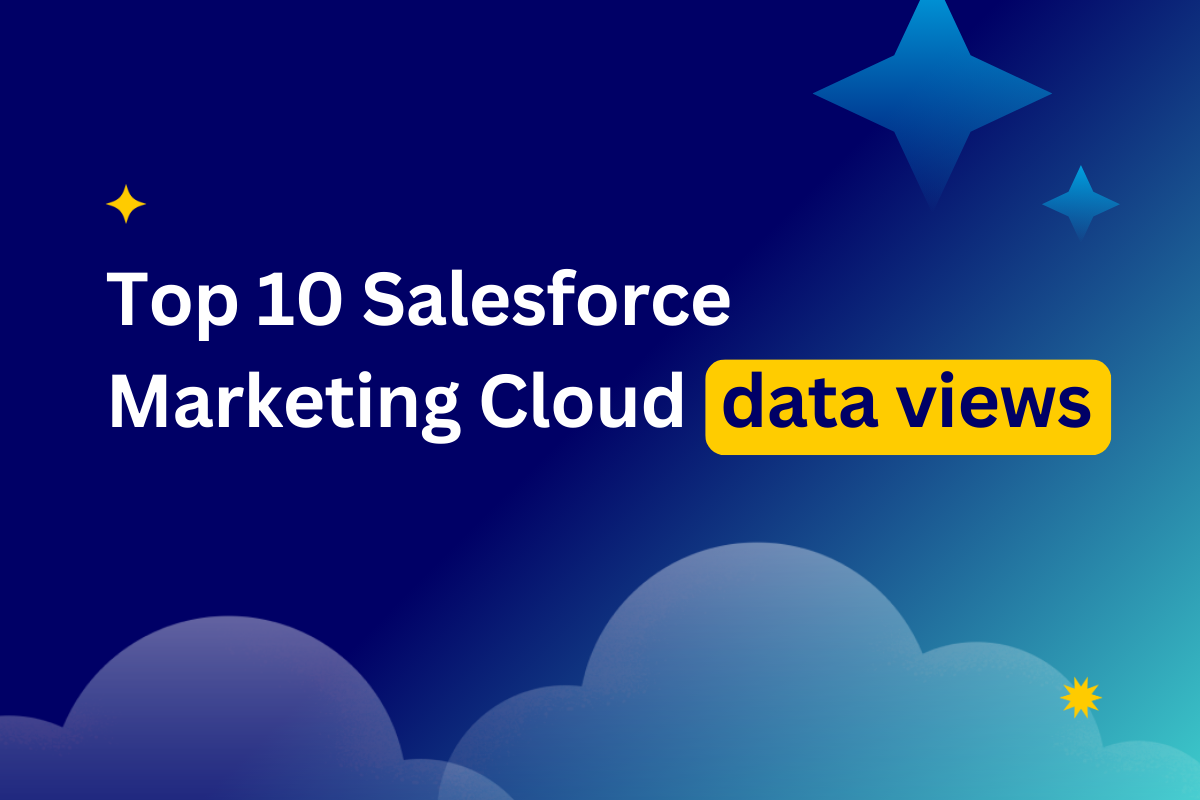
A little more than a year ago, we compiled our list of the top 10 data views in Salesforce Marketing Cloud. Today we decided this list could definitely use an update. Salesforce’s Marketing Cloud platform changes rapidly, and part of our job is to keep up, adapting accordingly. That’s why we decided to share our findings in this revised article, top 10 data views in SFMC [updated].
What are Salesforce Marketing Cloud data views?
Data views are system-generated tables (or data extensions (DEs) in Salesforce Marketing Cloud (SFMC). They contain different information about subscribers and events such as email/SMS sends, email opens, or links clicked. You can also view behavioral information such as emails forwarded to friends, or the status of your subscribers and contacts. In addition, it’s possible to view the bounce rate using data views in SFMC. In total, there are 24 different data views in SFMC that you can check out here.
Unlike with data extensions, you can’t find data views in the normal overview, which is why some marketers might have never heard of them. You can use data views to create queries in the Marketing Cloud using SQL. If you’re not too technically savvy and still want to leverage important information found in data views, you can use third-party no-code solutions like DESelect.
We actually have a nice guide on how you can leverage data views in Marketing Cloud to avoid marketing pressure that introduces you to querying data views in Marketing Cloud, using SQL and DESelect respectively.
The goal of this article, however, is to present a list of the 10 most important data views to use in SFMC — especially if you work with Email Studio. So let’s get to it.
Top 10 data views in SFMC [updated]
- _Subscribers
Using this data view you can find out which accounts are subscribers in SFMC, as well as know their status.
Check out this article where we explain how to exclude recently targeted audiences from your future campaign.
2. _Click
This data view is used to find out about the data on email clicks from your campaign in SFMC.
3. _Bounce
Using this data view you can find data on bounces from your email campaigns in Salesforce Marketing Cloud.
4. _Job
This data view allows you to obtain information about email send jobs in SFMC. It includes the email, account, job, and event-related data.
5. _Unsubscribe
Using this data view, you can obtain data on unsubscribes.
6. _Open
The _Open data view contains information about email opens within SFMC.
7. _Sent
Using this data view you can find subscribers to whom communication was sent from your Salesforce Marketing Cloud account.
For instance, you would like to get the details of all Contacts that have not received any emails in the last 14 days. Curious how to easily extract this information in SFMC? Check out our guide here.
8. _Journey
This data view concerns information regarding the Journey Builder. For instance, it stores the information about the journey’s status, the date it was created, and/or modified, created, and last modified, version ID, and number.
9. _ListSubscribers
Using this data view you can obtain information about the subscribers in your SFMC account on lists. It contains information about the subscriber, together with the email and unsubscribes information. This data view contains the information about subscribers found on the Triggered Send Managed List.
10. Data View _FTAF
Query this data view in Automation Studio to view behavioral information related to email messages from your Marketing Cloud account that were forwarded to friends.
Conclusion
In this article we combined the top 10 data views for Salesforce Marketing Cloud that can be used to segment your audience for your future email campaigns. Marketing Cloud data views contain a lot of relevant information that can be used in your email or mobile campaigns.
With DESelect you can easily create segments based on data views, without the need to apply SQL. If you’re curious to see how it works, book a demo with one of the DESelect professionals.
- What are Salesforce Marketing Cloud data views?
- Top 10 data views in SFMC [updated]
- Conclusion
Latest Articles
-
How to Measure the ROI of AI Copywriting Tools
How to Measure the ROI of AI Copywriting Tools AI copywriting tools have become essential for SaaS and consumer brands alike, not just for cutting the cost of content creation but also for winning new customers. But measuring the ROI of these tools goes beyond counting words generated or hours saved. Today, ROI also includes […]October 24, 2025 -
The Future of Generative AI in Copywriting
The Future of Generative AI in Copywriting Generative AI is already rewriting how copywriters, marketers, and brands create content. But the future? It’s far bigger than “faster blogs and ads.” The next decade of AI in copywriting will go beyond efficiency; it will reshape creativity itself, reframe how brands tell stories, and even redefine the […]October 23, 2025 -
Why AI Outputs Often Feel Too Generic
Why AI Outputs Often Feel Too Generic Content personalization has always been the holy grail of marketing. Delivering the right message to the right person at the right time can dramatically improve engagement, conversion rates, and trust. But scaling personalization across multiple buyer personas, industries, and customer journeys has traditionally been expensive and time-consuming. Generative […]October 23, 2025 -
Debunking the Biggest Misconceptions About AI Copy
Debunking the Biggest Misconceptions About AI Copy Artificial intelligence has officially gone mainstream in the marketing and sales world. Copywriting tools powered by AI are now being used everywhere: from email campaigns to product descriptions, ad copy to blog posts. But with this rise comes a swirl of myths, fears, and conspiracy theories about how […]October 17, 2025










